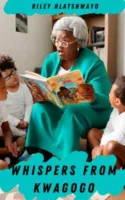Picture this scene: You’re 5 or 6 years old and visiting kwaGogo for the holidays. All your cousins and siblings are there, and you’re seated on the dining room floor waiting for breakfast or lunch to be served. UGogo and your Aunt arrive and give you all a meal and promises that if you finish everything on your plate, you will get a treat. You may hate the food depending on what you’re eating: while uGogo will try and use her pension to splurge on you, the Aunt will prioritise veggies, but you love treats the same, so that you will eat your veggies.
When you’re all done, uGogo comes back, hands each of you a sweet, and says, “Who wants to hear a story?” Eyes beaming up, you all shout sing-songily that you want a story. And so she begins, “Kwasuka sukela,” and in fashion, you respond with, “Cosi.” Then, the story begins.
As the world gets ready to celebrate World Storytelling Day on 20 March, I couldn’t help but be taken back to the time that made me fall in love with storytelling: the days of my childhood when my grandmother would sit us down and summon a world for us to inhabit for those few minutes.
World Storytelling Day is a day that celebrates the art of storytelling. Whether the story has words, pictures, signs, or expressions, all forms of storytelling are appreciated today. The day acknowledges the art form of storytelling and encourages diversity among different cultures and races.
It is a nostalgic exercise to understand oral tradition and its importance in sharing knowledge, cultural customs and stories from generation to generation by speech alone. It transcends the actual act of telling stories itself and reflects on our background as a people and how much family history we can mine from a single conversation.
Oral storytelling is how we realise the potential we have as people. It was the beginning of my love for stories and writing. While it opened up our view of the world, oral storytelling encompasses so much more than just telling stories and impacting the use of our minds.
In its simplest form, oral tradition is the method of passing down information from one generation to the next without writing or a recording medium. It was how many cultures in the past shared views, values and knowledge. With the changing times and climates, people evolved their way of doing things; some people started using oral tradition to supplement other methods like writing on stones and telling stories.
Siyanda, 23, mentioned how the exercise of oral storytelling helped her visualise things better, helping her unlock her imagination. She said, “I could see things clearer in my head as the story was told, and even days after, it would still linger in my head. The images stayed longer than the actual story itself.” This helped her so much more that it went beyond storytelling, utilising this gift of creating mental images in subjects like Life Sciences and Physics when her school lacked the physical material required to teach them the subject.
I understood this better when I was retelling a story my grandmother had told me, how oral tradition is our way of transcribing history and archiving our experiences as both families and a people. It is also how we use this gift we’ve been given and stretch it out to give it to the next generation because culture evolves when we do, and we do well when we move with the times.
How can we bridge the gap between the rich oral storytelling tradition and the digital age to preserve our cultural narratives for future generations?



